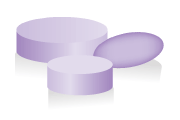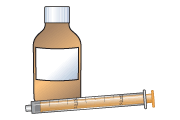Folic acid for megaloblastic anaemia caused by folate deficiency and haemolytic anaemia
This leaflet is for parents and carers about how to use this medicine in children. Our information may differ from that provided by the manufacturers, because their information usually relates to adults. Read this leaflet carefully. Keep it somewhere safe so that you can read it again.
Name of medicine
Folic acid
Brand names: Folicare®, Lexpec®
This leaflet is about the use of folic acid for two particular types of anaemia: megaloblastic anaemia, which may be caused by folate deficiency (lack), and haemolytic anaemia.
Why is it important for my child to take folic acid?
Red blood cells carry oxygen around the body, which they do using a protein called haemoglobin. In anaemia, the body does not have enough haemoglobin. Folic acid will help your child’s body to make healthy, normal red blood cells that can carry oxygen. This will improve your child’s symptoms of anaemia such as feeling tired, becoming easily breathless, dizziness (fainting) and headache.
What is folic acid available as?
Tablets: 400 micrograms, 5 mg; these may contain lactose
Liquid medicine: 2.5 mg in 5 mL
When should I give folic acid
Folic acid is usually given once each day. This is usually in the morning.
Give the medicine at about the same time each day so that this becomes part of your child’s daily routine, which will help you to remember.
How much should I give?
Your doctor will work out the amount of folic acid (the dose) that is right for your child. The dose will be shown on the medicine label.
It is important that you follow your doctor’s instructions about how much to give.
How should I give folic acid?

Tablets
- Tablets should be swallowed with a glass of water, squash or juice. Your child should not chew the tablet.

Liquid medicine
- Shake the medicine well.
- Measure out the right amount using an oral syringe or a medicine spoon. You can get these from your pharmacist. Do not use a kitchen teaspoon as it will not give the right amount.
When should the medicine start working?
Folic acid starts to work straight away, but it may be a few weeks before your child’s symptoms of anaemia start to get better. They will probably need to take folic acid for about 4 months to build up their body’s stores of folic acid so that the anaemia doesn’t come back. If your child has haemolytic anaemia, they may have to take it for longer.
What if my child is sick (vomits)?
If your child is sick less than 30 minutes after having a dose of folic acid, give them the same dose again.
If your child is sick more than 30 minutes after having a dose of folic acid, you do not need to give them another dose. Wait until the next normal dose.
What if I forget to give it?
Give the missed dose when you remember, as long as this is at least 12 hours before the next dose is due. You do not need to wake up a sleeping child to give a missed dose.
What if I give too much?
You are unlikely to do any harm if you give an extra dose of folic acid by mistake. If you are concerned that you may have given too much, contact your doctor or NHS Direct (111 in England and Scotland; 111 or 0845 46 47 in parts of Wales). Have the medicine or packaging with you if you telephone for advice.
Are there any possible side effects?
We use medicines to make our children better, but sometimes they have other effects that we don’t want (side-effects).
Your child is unlikely to get any side-effects with folic acid. Any side-effects that do occur are likely to be mild, and wear off after a few days. If they are still a problem after a week, contact your doctor.
- Your child may feel less hungry than usual (lose their appetite). Encourage them to eat small meals often.
- Your child may feel sick (nausea) or be sick (vomit). Giving the medicine with some food may help. They may also feel bloated or have flatulence (wind).
There may, sometimes, be other side-effects that are not listed above. If you notice anything unusual and are concerned, contact your doctor.
Can other medicines be given at the same time as folic acid?
- You can give your child medicines that contain paracetamol or ibuprofen, unless your doctor has told you not to.
Check with your doctor or pharmacist before giving any other medicines to your child. This includes herbal and complementary medicines.
Is there anything else I need to know about this medicine?
It is safe to take folic acid during pregnancy, but it is important that you follow your doctor’s instructions about how much to give.
General advice about medicines
- Try to give medicines at about the same times each day, to help you remember.
- If you are not sure a medicine is working, contact your doctor but continue to give the medicine as usual in the meantime. Do not give extra doses, as you may do harm.
- Only give this medicine to your child. Never give it to anyone else, even if their condition appears to be the same, as this could do harm.
- Make sure that you always have enough medicine. Order a new prescription at least 2 weeks before you will run out.
- Make sure that the medicines you have at home have not reached the ‘use by’ date on the packaging. Give old medicines to your pharmacist to dispose of.
If you think someone else may have taken the medicine by accident, contact your doctor straight away.
Where should I keep this medicine?
- Keep the medicine in a cupboard, away from heat and direct sunlight.
- It does not need to be kept in the fridge.
- Make sure that children cannot see or reach the medicine.
- Keep the medicine in the container it came in.
Who to contact for more information?
Your doctor, pharmacist or nurse will be able to give you more information about folic acid and about other medicines used to treat megaloblastic and haemolytic anaemia.
England: NHS 111
Tel 111
www.nhs.ukScotland: NHS 24
Tel 111
www.nhs24.scotNorthern Ireland: NI Direct
Wales: NHS 111 Wales
Tel 111
www.111.wales.nhs.ukCopyright disclaimer
Version [1]. © NPPG, RCPCH and WellChild, all rights reserved. Review by July 2015.
The primary source for the information in this leaflet is the British National Formulary for Children. For details on any other sources used for this leaflet, please contact us through our website, www.medicinesforchildren.org.uk.
We take great care to make sure that the information in this leaflet is correct and up-to-date. However, medicines can be used in different ways for different patients. It is important that you ask the advice of your doctor or pharmacist if you are not sure about something. This leaflet is about the use of these medicines in the UK, and may not apply to other countries. The Royal College of Paediatrics and Child Health (RCPCH), the Neonatal and Paediatric Pharmacists Group (NPPG), WellChild and the contributors and editors cannot be held responsible for the accuracy of information, omissions of information, or any actions that may be taken as a consequence of reading this leaflet.
